Mwalimu-G
Elder Lister
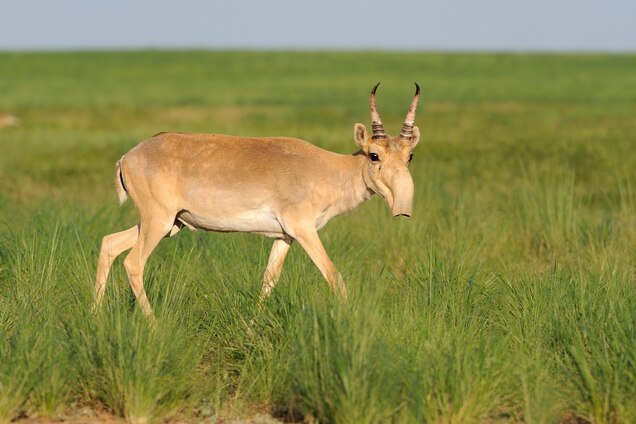
Long-snouted holdovers from the last Ice Age, male saiga antelope on the Central Asian steppes are hunted illegally for their horns, prized in Asian traditional medicine.
PHOTOGRAPH BY NATURE PICTURE LIBRARY, ALAMY
These Rare Antelope Face Double Jeopardy: Disease and Poaching
On the steppes of Central Asia, saiga antelope have survived a mysterious disease. But poaching for their horns is a continuing threat.
BYJOHN WENDLE
PUBLISHED AUGUST 28, 2018
Roaring at high speed, the rangers’ Soviet-era jeep rumbles over the hot plains of the Kazakh steppe, shimmying violently. In the back seat, piles of dirty camouflage jackets, oily assault rifles, dinged-up binoculars, and bags of macaroni go flying at every jolt. This is the basic gear an anti-poaching patrol needs for weeklong forays into the Central Asian interior to stop hunters from killing saiga antelope for their slender, ribbed horns, which are highly valued in Asian traditional medicine.
Suddenly Bakhytzhan Kubanov yells at the driver, who skids the jeep out of the ruts to a halt. The 59-year-old ranger springs from his seat, waving his arms for the wardens following behind to stop too.
“Ha! That was close!” he shouts at his comrades as he trots toward their van. Almost right in front of the vehicle’s tires, he bends down and yanks an eight-inch-long spike from the cracked ground.
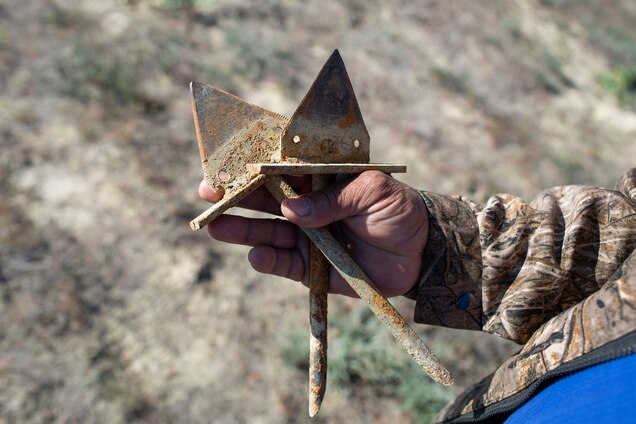
A ranger holds a “thorn,” as these handmade metal spikes are called. Poachers use them to shred the tires of rangers’ vehicles.
PHOTOGRAPH BY JOHN WENDLE
“Poachers set these for us,” Kubanov says, holding out a dirty steel rod with a triangular barb welded to the top. The “thorn,” as he calls it, is filed to a knife edge and is shaped like a big rusty shark tooth. “When we chase them, they put these in the tracks,” Kubanov says. “If we drive over them, the tire explodes.” I have no idea how Kubanov spotted it, going as fast as we were—but he’s spent the past 11 years honing his skills patrolling the 4,500-square-mile Irgiz-Turgay nature reserve, in the heart of Kazakhstan some 400 miles southwest of the capital of Astana.
This is the sometimes perilous cat-and-mouse game rangers and poachers play in their conflicting races to protect a species from extinction and to make money. “They shoot the saiga, then they saw off the horns and sell them on the black market,” Kubanov says.
For the poachers, the risk—and the carnage—are worth it. Saiga horns are sold to smugglers and middlemen for sums substantial enough to tempt impoverished Kazakh villagers, and because saiga often congregate in large herds, scores can be picked off at a time.
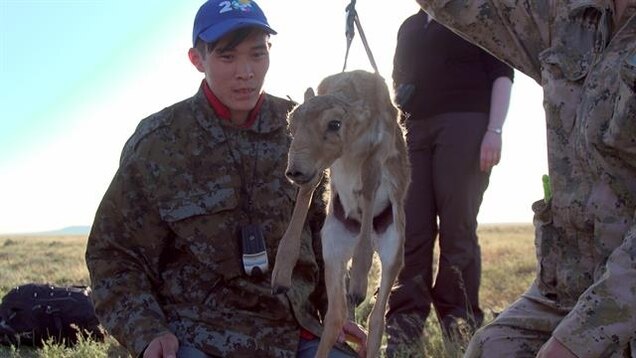
6:06
Saiga Antelopes, plagued by disease and prized for their horns, are at the center of conservation efforts in Central Asia.
VIDEO BY JOHN WENDLE
Saiga are found in Russian and Mongolia—but mainly in Kazakhstan. It's illegal to export saiga horn from any of these range states, but in countries such as China, Malaysia, and Singapore, products made from saiga horn reserves dating back to the 1990s are sold legally in traditional medicine shops. This legal system allows traffickers to launder in newly poached saiga horn, and there's no way to tell whether what's on the shelves comes from old, legal horn or contemporary, illegal horn.
Millennials in particular favor saiga horn products, downing bottles labeled as “saiga horn cooling water” and touted as a detox. In China some 21,000 pounds are consumed each year in shavings, tablet, and powder form, according to Daan van Uhm, a specialist in wildlife and environmental crimes at the University of Utrecht. Buyers pay extreme markups, sometimes thousands of dollars, over prices in Kazakhstan.
For a study published in the conservation journal Oryx in March 2018, researchers surveyed 230 Chinese Singaporeans and found that 13 percent of them had consumed some kind of saiga traditional medicine during the past year. Of those, 25 percent were between the ages of 18 and 35—surprising, perhaps, because young people are often more conscious of the need to protect wildlife. But, according to the Oryx study, “awareness of conservation issues and regulations was uniformly low.”
It’s not only the traditional Asian medicine products that have landed Saiga tatarica, a long-snouted holdover from the last Ice Age, on the Critically Endangered Red List of the International Union for Conservation of Nature, which sets the conservation status of species. Along with illegal hunters, the animal has faced a bacterial plague that killed off 220,000 saiga—62 percent of the world’s population—in just a few weeks in 2015.
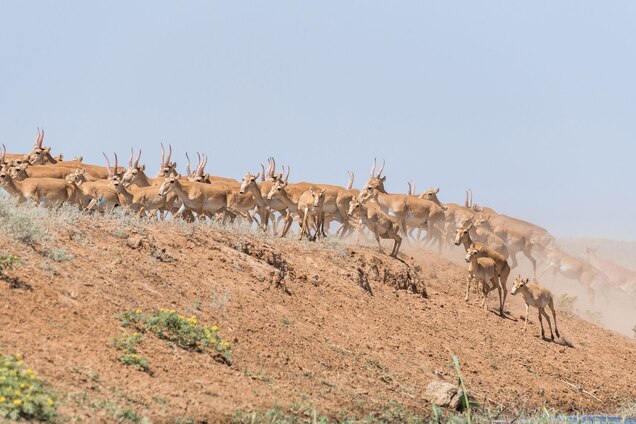
Saiga congregate during the autumn months to mate, making the horned males especially vulnerable to large-scale poaching.
PHOTOGRAPH BY NIKOLAY DENISOV, ALAMY
“This population we’re monitoring here almost vanished—almost 90 percent died,” said Steffen Zuther, project coordinator for the Altyn Dala Conservation Initiative, a wide-ranging program in the Irgiz-Turgay region. And, Zuther added, saiga are also threatened by loss of habitat from road and rail construction and infrastructure development, which impede their seasonal migrations to new pastures.
Zuther estimates that the total 2018 saiga population in the three range states is some 225,000—about a quarter of what it was four decades ago. (In China, saiga went extinct from overhunting during the 1960s.)
SAIGA SCIENCE
This spring I joined Zuther and researchers from the Royal Veterinary College in London as they undertook the grueling four-day journey through trackless steppe to saiga birthing grounds in Irgiz-Turgay reserve. It was there that Zuther introduced me to Kubanov and his fellow rangers.
The researchers’ goal was to carry out a census to assess how the little studied saiga are doing and to collect tissue samples to understand how the deadly bacteria interacts with the population.
In the noon heat everything shimmered as if seen through thick panes of melting glass. My eyes adjusted to the mirage, and where before I’d seen only the beige of the steppe, I suddenly saw saiga. They were everywhere, and they were all watching us. Then they ran.
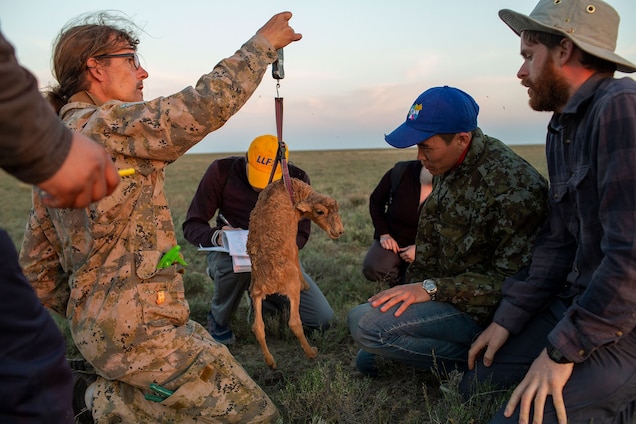
Researcher Steffen Zuther, of the Altyn Dala Conservation Initiative, weighs a baby saiga. The baby will be fitted with a tag as part of an ongoing effort to learn more about these little studied animals.
PHOTOGRAPH BY JOHN WENDLE
“It looks as if the saiga have wheels—they look like motorbikes going through the steppe,” Zuther said with unconcealed enthusiasm. Indeed, saiga can reach speeds of 50 miles an hour, an adaptation for when big cats hunted them across Europe’s flat expanses during the last Ice Age.
In fact, the compact antelope—with its short legs and mini-elephant nose used for air conditioning and dust filtering—looks more like a 1980s Black & Decker DustBuster than a motorcycle. Buzzing across the steppe, it snaffles tender spring shoots of rhubarb (favorite food) and sage (second favorite).
The young ones are easier to catch than the adults—programmed to freeze and hide rather than run. Using this to their advantage, the researchers weighed, sexed, and measured hundreds of the creatures before putting a numbered tag in their ears. Zuther explained that the hope is that when these saiga die, the researchers will find them and learn from the tags how long saiga generally live.
Around us the adult females gathered into a giant herd of thousands to birth their young, making their low, morgk sounds at us. Later, as I sat alone filming them, they got closer. Normal vocabulary fails their otherworldly appearance, and I wrote a note on my phone describing them as a “stonking snorfle of morgks.”
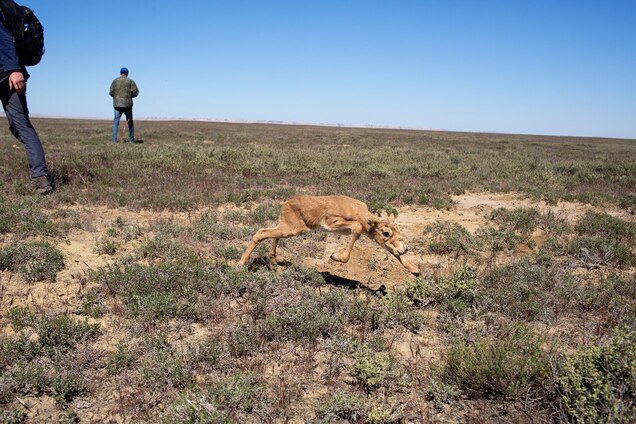
Even when just days old, baby saiga can run at high speed, but more often than not they try to become invisible in place.
PHOTOGRAPH BY JOHN WENDLE
Unfortunately, not even their remoteness protects saiga from Pasteurella multocida, the bacterium that was so deadly in 2015; it occurs naturally in the animals’ tonsils. Scientists think the bug somehow becomes deadly when hotter and wetter temperatures than normal coincide with the spring birthing period. Temperatures in Central Asia are increasing at twice the global rate, which means that the potential for more mass die-offs could also be increasing. But researchers are still trying to understand how the trigger works.
One cause for hope is that saiga breed rapidly and recover quickly. Another is that rangers like Kubanov seem to be doing their job. “The protection from poaching is rather good at the moment, so populations are now doing well,” Zuther told me. But, he cautioned, “these die-offs can happen any time, so we must prepare for that.”
Zuther’s note of optimism aside, saiga poaching remains a serious problem. The peak time is the autumn months, when the males gather to butt heads and win hearts. Because only male saiga have horns, the killings drastically skew the sex ratio, sometimes leaving only five adult males for every hundred females, according to one study, causing herds’ reproduction rates to drop.
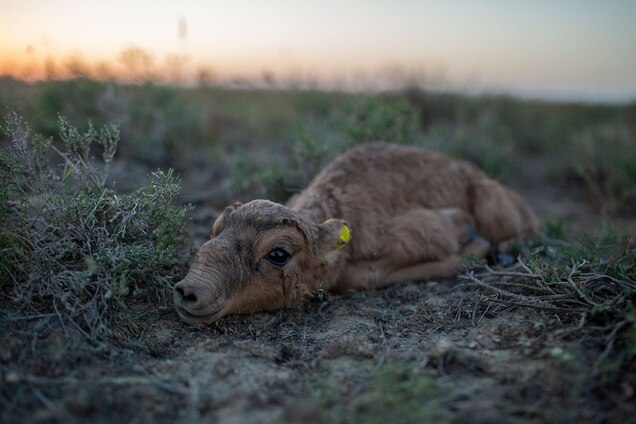
This tagged baby hunkers in hiding mode, its color blending with the steppe, making it less vulnerable to predators like eagles.
PHOTOGRAPH BY JOHN WENDLE
LOCKED IN A STRUGGLE
Back in Irgiz-Turgay reserve, Kubanov and the other rangers park their vehicles on a small hill, wrapping up their morning patrol. They scan the wind-raked steppe with their binoculars. Then they cook up a lunch of macaroni, mutton, and tea on a homemade gas stove. It all seems relaxed enough, but these rangers are locked in a fierce struggle with the poachers. Indeed just last year the outlaws burned down seven of the 20 cabins they use in the winter, says Mereke Zhubaniyaz, deputy director of the reserve.
After their meal, they explain the severity of the problems they face. The three older wardens say the poachers have better weapons, better vehicles, and better communications. On top of this, the rangers earn only about $180 a month, they say, which makes it tempting to join the poachers. Just last year, a team of seven rangers was caught poaching in the reserve; each was fined more than $17,000, according to the rangers I interviewed.
For Kubanov and the others, all of whom are from the impoverished village of Taup, a penalty that severe would be devastating. Even so, they all agree that, as Kubanov says, “the law is too soft. It’s necessary to be even tougher—then the poaching will stop.”
Because curbing demand for saiga horn in Asian countries is a daunting task, scientists, conservationists, and government officials think that improving the livelihoods of both illegal hunters and rangers would be a more effective way to reduce the poaching.
“The work of rangers is really crucial,” Zuther says. “We're still working on a mechanism to improve their status and their payment so they’re more motivated to protect saiga. It's a process which is ongoing in the government.”
“The question is money,” as Kubanov puts it. “Money decides everything for us. You understand, it's corruption. There is someone sitting on top who controls everything—sends [the horns] to China, opens the channels everywhere, organizes everything.”
Many agree with him. Zhubaniyaz, although reluctant to talk about it, says that individuals within different government ministries are involved, but he couldn’t cite specifics. In 2018, Kazakhstan ranked 122 out of 180 countries on Transparency International’s corruption list, and Kazakhs say they routinely see and experience corruption.
Deregulation and widespread corruption after the fall of the Soviet Union led to the mass killing of saiga in the 1990s and 2000s. “In the past, saiga were everywhere, but they were shot during the last couple of decades by professional hunters in helicopters,” an unnamed former hunter is quoted as saying in Van Uhm's research. “It was organized by the Kazakh mafia that dominates government officials. It was due to the high demand for medicines from China,” the former hunter says.
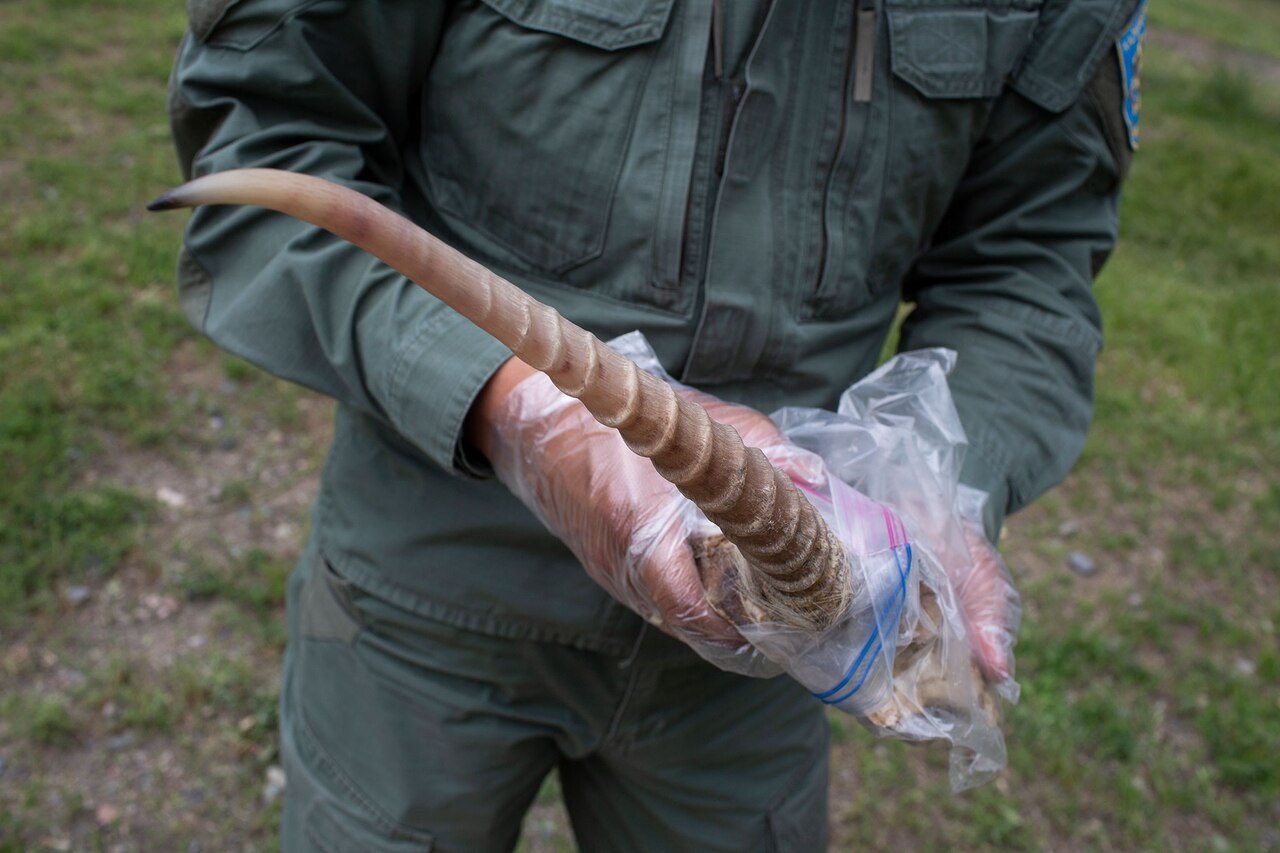
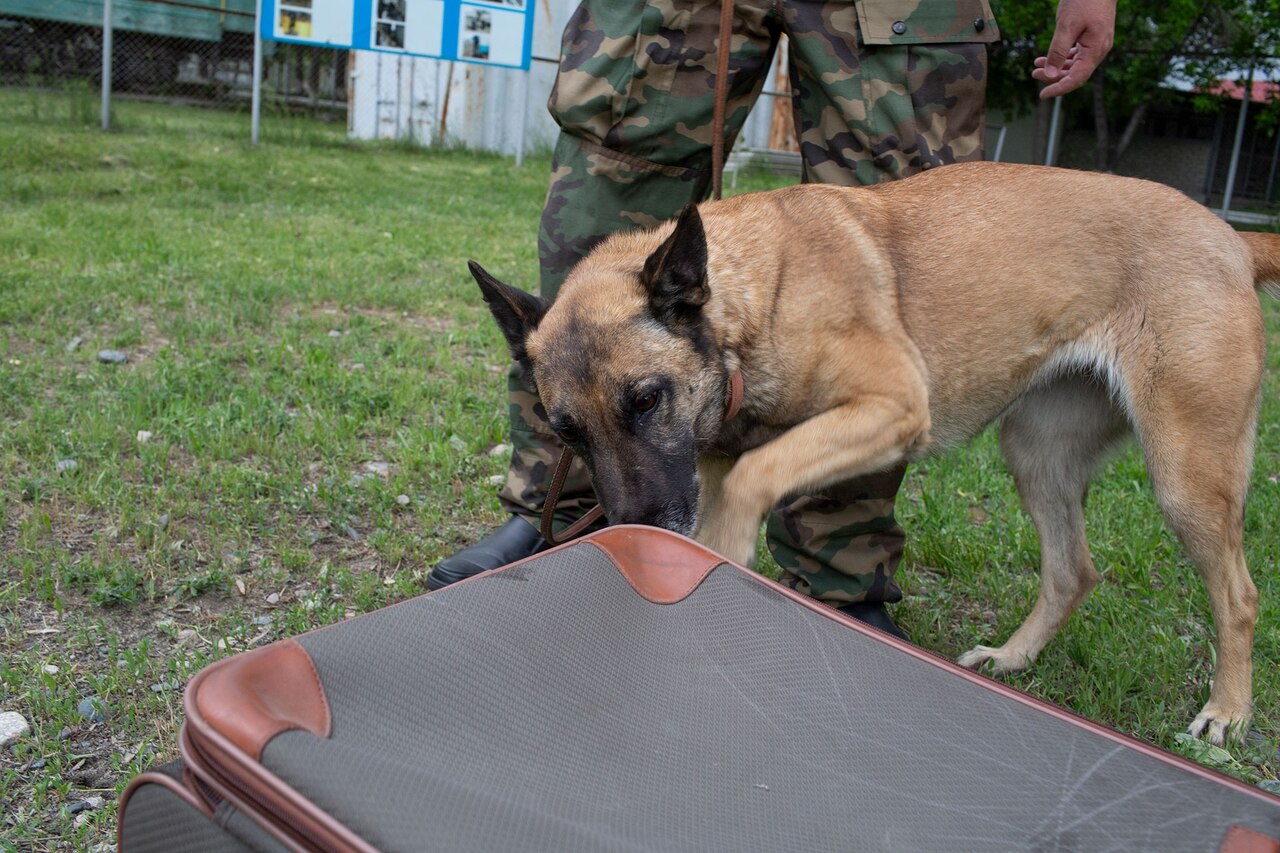
Left: At a facility outside the city of Almaty, the Kazakhstan customs service uses confiscated whole and powdered saiga horn to train three saiga sniffer dogs—the only ones in the world—to intercept saiga contraband at the borders.
Right: Nose power: When suitcases are laid out in a field at the training facility, the dogs almost always identify the one that contains saiga horn.
PHOTOGRAPH BY JOHN WENDLE
Today poaching continues, as evidenced by the need for specially trained dogs, although Akan Tursynbaev, the executive officer at the customs service’s sniffer dog training facility in Almaty, Kazakhstan’s biggest city, says things are better now.
“I can say that to date the laws have been tightened,” he said. “I think that there is no such obvious corruption.” But when asked which laws have been tightened, he couldn’t name one.
At the center’s training field on the outskirts of Almaty, Tursynbaev demonstrated the skills of Ginny and Duck (German shepherds) and Cherry (a Belgian shepherd). He set up a row of empty suitcases, one of which contained whole and powdered saiga horns. The dogs homed in on it and sat waiting for him to congratulate them with a treat.
These three are the world’s only dogs trained to detect saiga horn, and Tursynbaev considers them the ultimate deterrent.
“What does a dog need?” he asked. “A dog needs a trainer's love, a bowl of food, and a favorite ball. That’s why she works. She doesn’t need gold; she only needs love.”
